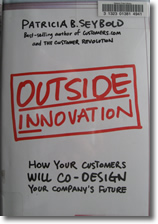“Push here to lock end” – are you hiding innovations from customers?
[display_podcast]
This podcast is 3 minutes 51 seconds long. The text is available here.

“Push here to lock end” – are you hiding innovations from customers?
This podcast is 3 minutes 51 seconds long. The text is available here.
Over the Thanksgiving holiday I learned something quite startling.
The age-old problem of rolls of aluminum foil, plastic wrap, and other rolled goods jumping out of the box when you are dispensing them was actually solved years ago by a clever packaging engineer.
My sister-in-law, Meredith Morgan,  an award winning chemistry teacher at Governor Livingston HS in Berkeley Heights NJ, learned this from her students one day when she was fumbling around in front of a class with a roll of aluminum foil.
an award winning chemistry teacher at Governor Livingston HS in Berkeley Heights NJ, learned this from her students one day when she was fumbling around in front of a class with a roll of aluminum foil.
“Dr. Morgan, don’t you know about the little tabs your press in on the ends of the box?”
She didn’t. But she learns quickly. Meredith was so impressed by this innovation that she demonstrated it to me on every box of foil, plastic wrap, and wax paper in the kitchen.
Now, you might ask, “What does this have to do with my business?”
This is a good example of a small innovation with very practical, day-to-day utility that has probably never been marketed beyond the end of the box. Yet, it works well, addresses an annoyance that every consumer has experienced, but, somehow the solution has remained unused, probably by most consumers.
Note that once you learn of this little push-in tab, you will probably look for it on the end of every box of roll goods you buy. You may wish to follow this discovery on the Web, search on Google for “press here to lock end”
A further example of hiding innovations comes from a customer advisory board meeting for the Albany NY region of a major telecommunications provider. During this meeting, attended by many major customers from health care, high tech, industry, and government, a number of customers said, in response to the comments of other customers attending, “They provide you with that service? I did not even know that they offered that!” Here were major customers of a large, successful telecom who were not aware of significant service offerings. Needless to say, this telecom learned that their marketing efforts were ineffectual and needed more work. If you current customers do not know of your product or service offerings, how could potential customers discover them?
Have you made innovations in your products or services but never told your customers about them? Do you make innovations without even involving customers? When was the last time you actually asked your customers what they like about your products? Have you examined how customers use your product or service? Do you have a formal process to gather customer feedback? Do you have a Customer Advisory Board to drive innovations?
It is widely accepted that the more closely tied, integrated even, customers are in your development process for new products and services, the more likely success will follow. An April 13, 2008 article in the New York Times Magazine, “Can the Cellphone Help End Global Poverty – why a corporate ‘user anthropologist’ is spending so much of his time in the shantytowns of the world” (by Sara Corbett) sets a new standard. Nokia has Jan Chipchase wandering about the world seeking out what the next three billion cell phone users desire.
The first billion cellphones sold in 20 years; the second billion in four years; and the third billion in two. 80% of the worlds population live within range of a cellular network. The uses cell phones are already being put to in the underdeveloped world are quite unlike those in the developed countries. The only way to understand these and to begin to elicit input from new users is to go out and ask them, face-to-face. So, Nokia has full time personnel, on the ground, sending reports back to headquarters and trying out mockups of potential new products with real people.
It would serve everyone who is envisioning a new product or service to ask themselves:
Don’t let your engineers, marketers, sales people, or worse, you own enthusiasms, substitute for live human feedback.
May 5th, 2008
The transformation of “customer driven”, “customer-centered”, “customer-defined” from just empty buzzwords in the latest management books to central values, key strategic skills is continuing.
 Patricia Seybold’s 2006 book Outside Innovation: How Your Customers Will Co-Design Your Company’s Future (Harper Collins, New York 2006) provides a broad review of many techniques used by a wide range of companies to incorporate customers and customer ideas into product design. The book is sufficiently current to include examples for web-centered customer environments. Ms. Seybold has gathered a large number of examples in varying market segments. This makes the book a worthwhile read just for these through examples. Unfortunately, the formalization of the ideas remains low. This makes this book look and feel like a collection of anecdotes. The book closes with “Five Steps to Outside Innovation”, “Five Core Competencies to Master”, and “Five Pitfalls to Avoid”. Unfortunately Ms. Seybold never really develops her copywrited, “Customer Scenario” to organize the methods and approaches to get beyond the notion that customer inputs to innovation are a series of “I want….” statements.
Patricia Seybold’s 2006 book Outside Innovation: How Your Customers Will Co-Design Your Company’s Future (Harper Collins, New York 2006) provides a broad review of many techniques used by a wide range of companies to incorporate customers and customer ideas into product design. The book is sufficiently current to include examples for web-centered customer environments. Ms. Seybold has gathered a large number of examples in varying market segments. This makes the book a worthwhile read just for these through examples. Unfortunately, the formalization of the ideas remains low. This makes this book look and feel like a collection of anecdotes. The book closes with “Five Steps to Outside Innovation”, “Five Core Competencies to Master”, and “Five Pitfalls to Avoid”. Unfortunately Ms. Seybold never really develops her copywrited, “Customer Scenario” to organize the methods and approaches to get beyond the notion that customer inputs to innovation are a series of “I want….” statements.